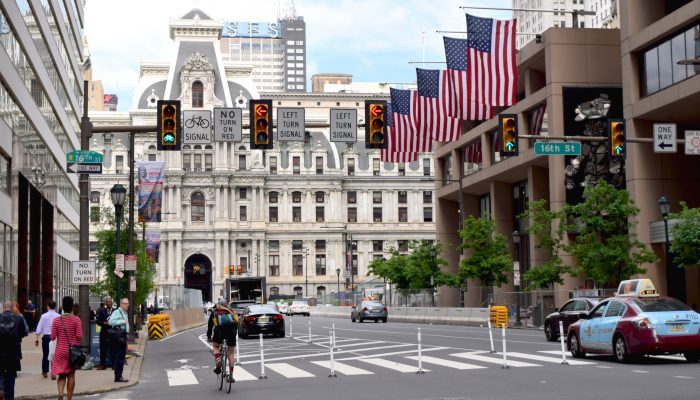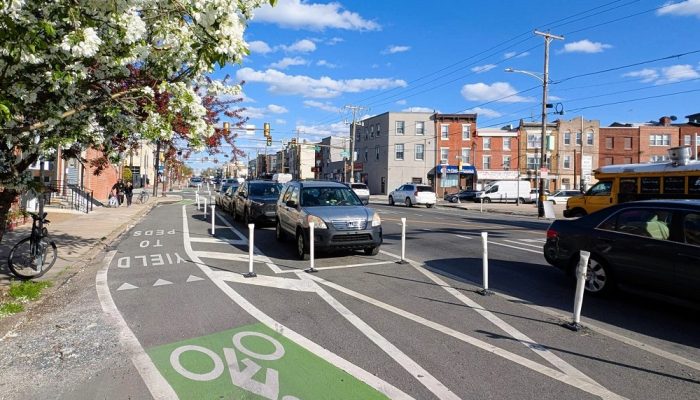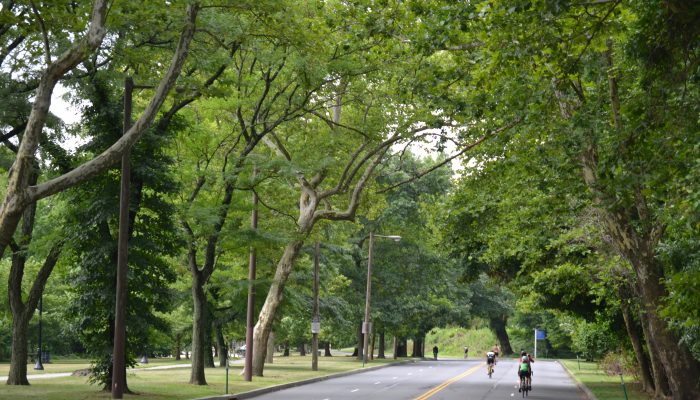The Market/JFK Vision Zero Safety Pilot Project is nearly complete! This project covers Market Street and JFK Boulevard from 15th to 20th Streets. The project is being led by the City’s Office of Transportation & Infrastructure Systems (oTIS) and will run for up to nine months.
Why is this project happening?
The improvements included in the pilot are part of a Complete Streets redesign. Complete Streets are designed to ensure safe access for all users, including pedestrians, bicyclists, motorists, and transit riders.
What changed on Market and JFK?
- Streets Department contractors used striping and flexible delineator posts to remove a travel lane along each street. This will reduce speeding and weaving.
- The project added new striping and flexible delineator posts to form a parking protected bicycle lane on most blocks to accommodate all roadway users.
- The parking and loading layout on each block was updated to reflect the new layout and shift uses. This was done in partnership with the Philadelphia Parking Authority.
- Turn lanes were added at key intersections to ease turning vehicular traffic along the corridors.
- Finally, the Streets Department installed Philadelphia’s first bicycle traffic signals as part of the project. These can be seen at the 16th & Market and 20th & JFK intersections.
What about the construction along Market Street?
There are several blocks of Market Street that are under construction and look different than the other projects in the pilot. oTIS and Streets Department are working closely with the construction management entities on those projects to make sure we can jointly move forward the goals of pilot project during construction.
What is being done for education and enforcement?
Besides the physical improvements, oTIS is working with the 9th Police District on education and traffic safety enforcement efforts during the pilot. District 9 officers began on-street education last week by handing out palm cards to drivers who did not yield to pedestrians in crosswalks and bicyclists riding on the sidewalk. The educational period will last for two weeks, after which District 9 officers will begin giving out traffic tickets.
Another educational element of the pilot is bicycle-facing educational signage to be installed soon on the flexible delineator posts. The signage will remind bicyclists to yield to pedestrians and those loading in the parking lane.
How will this project be evaluated?
Evaluation is an important piece of the pilot project. oTIS worked with Streets, DVRPC, Center City District, and others to gather nearly 15 metrics under the goals of Safety, Mobility, and Quality of Life. These metrics were gathered before the pilot and data gathering will be repeated during two points in the pilot for evaluation.
What happens after the pilot is complete?
The pilot project will be in place for up to nine months to allow for evaluation of benefits and impacts over many seasons. In fall 2018, oTIS and Council President Clarke’s office will review the evaluation data and feedback to determine next steps.
Who is leading this project?
oTIS convenes a Project Steering Committee of key stakeholders. This group tracks the progress of the pilot and next steps towards education, enforcement, and evaluation.
Members of the group include oTIS, the Streets Department, Council President Clarke’s office, the Philadelphia Parking Authority, the Commerce Department, the Center City District, neighboring civic organizations, and property owners and building managers along the corridor.
Who can I contact with questions?
If you have any questions or concerns about the project, please contact otis@phila.gov. If you see a recurring parking problem, please tweet a photo to @philaparking or call (215) 683-9775. For more information about the project, please visit: http://www.phila.gov/otis/completestreets.




